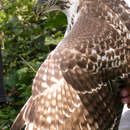More info for the terms:
cacti,
forest,
grassland,
hardwood,
shrubs,
tree,
tundra,
woodlandRed-tailed hawks occupy a wide variety of open to semiopen habitats.
They generally avoid tundra and dense, unbroken woodland [
1,
9,
25,
13].
Open to semiopen coniferous, deciduous and mixed woodlands, woodland
edges, grasslands, parklands, rangelands, river bottomlands, and
agricultural fields with scattered trees are preferred. Forest
clearings, alpine meadows, estuaries, and marshes are also commonly used
[
6,
8,
22,
34,
39]. Hardwood draws surrounded by native prairie are
important habitats in the Great Plains [
9]. In Wyoming and Montana,
red-tailed hawks nested in several habitats, but nests were most
numerous in riparian zones. Upland draws with adjacent grassland or
agricultural tracts were also commonly used [
51].
Nesting habitat - Red-tailed hawks usually nest in a tall tree in or at
the edge of woodlands, or in an isolated tree in an open area [
1,
9,
13].
Red-tailed hawks frequently select the largest and tallest tree
available [
1,
13]. In treeless areas red-tailed hawks nest on rocky
cliffs or talus slopes, or in shrubs or cacti [
13,
28]. In the Sonoran
Desert, red-tailed hawks often nest in large saguaro (Carnegiea
gigantea) with projecting limbs [
38]. Red-tailed hawks also nest on
artificial nest structures, the crossbars of utility poles, and towers
[
25,
38,
44]. They sometimes add to an existing raven, crow (Corvus
spp.), gray squirrel (Sciurus spp.), or buteo (Buteo spp.) nest [
38].
The nest is generally constructed next to the trunk of a tree in a
crotch or fork from 30 to 90 feet (9-27 m) above the ground [
13,
46].
Where tall trees are unavailable nests may be located almost on the
ground. Red-tailed hawk nests are at most 6 feet (0.9 m) above the
ground in paloverde (Cercidium spp.) [
38]. Nests are often reused from
year to year provided that the nests are not occupied by earlier nesting
raptors [
20,
51]. The mean distance between occupied nests in Wyoming
and Montana was 1.5 miles (2.4 km) [
51].
Red-tailed hawks nest in a wide variety of tree species [
8,
43,
44,
45,
51].
In central Missouri, 99 percent of red-tailed hawk nests were in
deciduous hardwoods. Sycamore (Platanus occidentalis) was the most
frequently selected species (40%). Other species included white
oak (Quercus alba), 32 percent; black oak (Q. velutina), 19.1 percent;
shingle oak (Q. imbricaria), 1.9 percent; eastern redcedar (Juniperus
virginiana), 1.9 percent; red oak (Q. rubra), 0.9 percent; American elm
(Ulmus americana), 0.9 percent; green ash (Fraxinus pennsylvanica), 0.9
percent; shagbark hickory (Carya ovata), 0.9 percent; mockernut hickory
(C. tomentosa), 0.9 percent; and eastern cottonwood (Populus
deltoides), 0.9 percent [
45].
In Snohomish County, Washington, only black cottonwood (Populus
trichocarpa) and red alder (Alnus rubra) were utilized for nesting. No
nests were found in conifers [
43]. In the highlands of southeastern New
York and northern New Jersey, red-tailed hawks built nests in 10
different species of trees, with the majority in oaks (82%) [
44]. In
Wyoming and Montana, the majority (51%)of red-tailed hawk nests were
found in coniferous trees. Forty-seven percent of the nests were found
in deciduous trees and 2 percent were located on cliffs [
51]. In
British Columbia, coniferous trees (48%; 8 species) were used slightly
more that deciduous trees (44%; 4 species). Black cottonwood (38%),
Douglas-fir (Pseudotsuga menziesii) (19%), and ponderosa pine (Pinus
ponderosa) (19%) were used most often [
8].
Only 13 percent of the red-tailed hawk nests in a study area in
Wisconsin were located in closed-canopy woodlots. Fifty-eight percent
of the nests were located in open groves, generally less than 1 acre
(0.4 ha) in size. Twenty-nine percent were located in isolated trees
along fencelines and ditchbanks. The majority of the nest trees were on
well-drained upland sites [
19]. Houston and Bechard [
21] documented the
increase of nesting red-tailed hawks following the expansion of trees
into the prairie regions of Saskatchewan [
44].
Foraging habitat - Red-tailed hawks generally forage in open habitats
containing lagomorphs, small rodents, and snakes. During the nesting
season red-tailed hawks usually forage within 1.9 miles (3 km) of the
nest [
25]. They are often observed hunting in clearcuts and
non-forested areas [
35]. Red-tailed hawks usually search for prey from
elevated perches [
20,
23,
38]. Consequently, they commonly occupy areas
that provide a relative abundance of potential perching sites [
23].
James [
23] found that 40 percent or more or the average red-tailed hawk
home range contained at least 10 perches per 40 acres (16.2 ha). Snags
are commonly used for perches [
12,
14,
31]. Red-tailed hawks in central
Iowa tend to select perches in groves of trees and along woodland edges
[
53]. Foraging habitat in the Midwest is limited by large expanses of
cereal crops [
9].
Winter habitat - Winter habitat for red-tailed hawks is generally the
same as the nesting habitat, except that high elevation areas are not
used [
25]. Wintering red-tailed hawks in Illinois avoided plowed fields
and showed a preference for high perches in areas with groups of trees
or small woodlots [
9].

